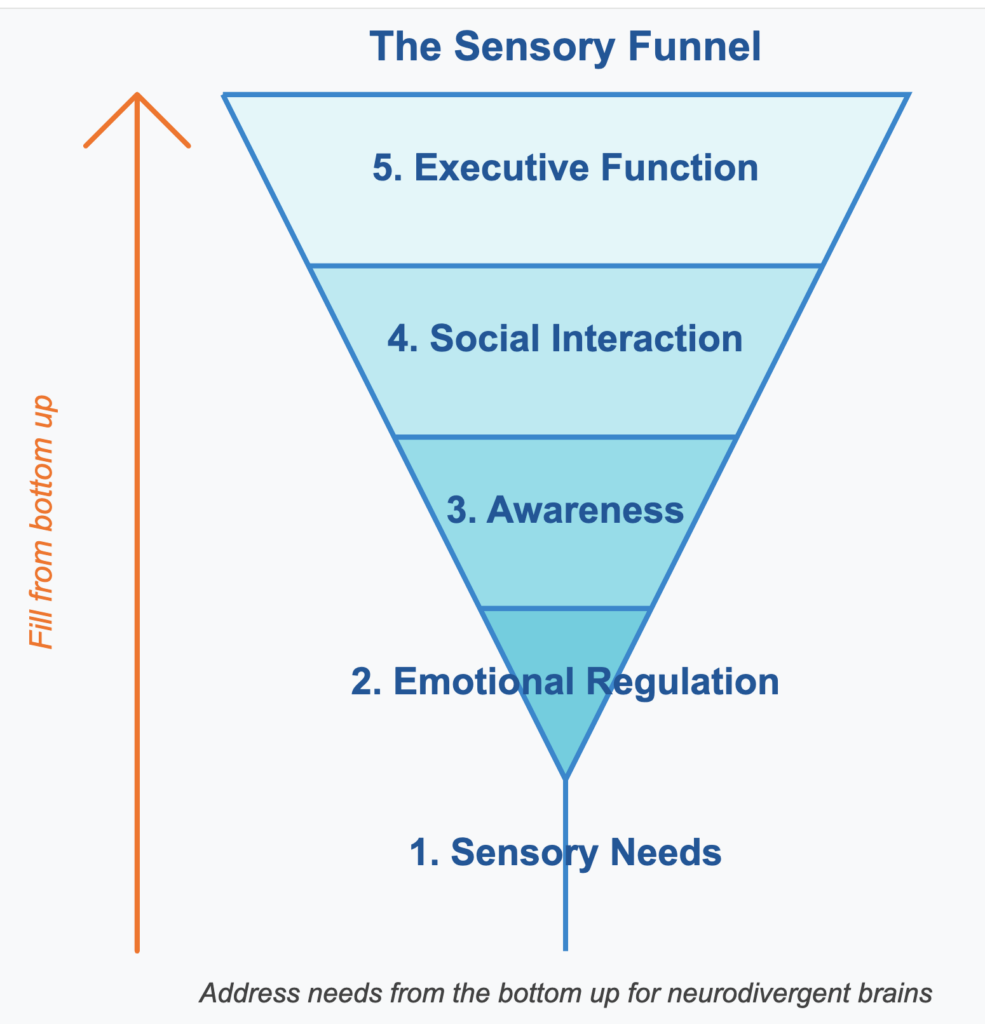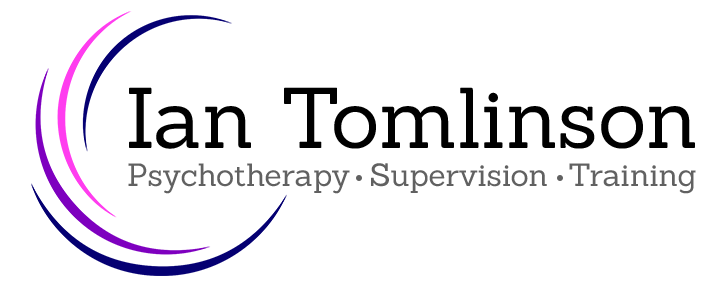Filling Your Funnel From The Bottom Up: Practical Strategies for Autistic and ADHD Nervous Systems
TL;DR: The Sensory Funnel is a five-level framework (Sensory → Emotional → Awareness → Social → Executive Function) that suggests addressing needs from the bottom up instead of focusing only on productivity. For neurodivergent nervous systems, meeting sensory needs first (like sleep, nutrition, and sensory regulation) creates the foundation for emotional balance, present awareness, social connection, and finally, executive function. This approach works with your nervous system’s natural processing instead of fighting against it.
I guess you’ve been there, you’ve got stuff to do but actually getting it done feels impossible.
Many of us neurodivergent autistic and ADHD folks can really get in a tussle with executive function (getting stuff done).
We can try so hard to do the thing we are expected to do when in reality we are just so dysregulated that we haven’t a hope in hell of completing that “task”.
From a spoon theory perspective, we expect ourselves to function efficiently in life when all of our spoons have been used up just coping with our environment, lack of sleep or that bloody car alarm that won’t stop going off in the street.
This is where the sensory funnel comes in. Starting from the bottom of your needs pyramid might be the game-changer you’ve been looking for.
What Even Is This “Sensory Funnel” Thing?
I first came across the sensory funnel from Danny Raede. Danny talks about it from an autistic perspective but it also fits with ADHDers and AuDHDRs too.

Imagine your nervous system processing as a funnel with different layers. Most neurotypical approaches focus on the top layer – executive function stuff like completing tasks, meeting deadlines, and organizing your life. But here’s the revolutionary idea: what if we filled the funnel from the bottom up instead?
For autistic and ADHD nervous systems, this makes so much sense! How are you supposed to focus on that report when the fluorescent lights are screaming at your eyeballs, your shirt tag feels like sandpaper, and you’re still trying to process three different conversations happening nearby?
The funnel has five layers, from bottom to top:
- Sensory needs
- Emotional regulation
- Awareness
- Social interaction
- Executive function
Let’s explore practical strategies for each level that actually work for our beautifully different brains!
Level 1: Sensory Needs – Your Foundation
This is your starting point, friends. Nothing else works if this level isn’t addressed. Autistic people and ADHDers have a more sensitive nervous system so it makes sense that we are going to struggle to do anything if this is overloaded.
Nick Walker, the psychologist and author of Neuroqueer heresies*, explains that neurodivergent neurology is different to those who are neurotypical. The neurodivergent brain is higher in synapses and as such is more responsive. The neuro brain registers more of what’s going on and the response to this can be unpredictable.
No big surprise then, that if you’re dealing with sounds, smells or visual stimuli that are overwhelming, you’re going to need to work out how to soothe yourself before thinking about getting that task done.
Let’s look at some of the basic ways in which you might do this:

Sleep is non-negotiable: I know, I know – sleep can be elusive when your brain won’t stop buzzing. Try creating a consistent routine that signals “sleep time” to your nervous system. This could involve dimming lights an hour before bed, using a weighted blanket (I bloody love my weighted blanket, I think it might be magical), or playing the same gentle soundtrack every night. Experiment to find what helps your unique system power down.
Food is fuel, not an afterthought: Ever notice how your executive function tanks when you’re hungry? Keep protein-rich snacks in every bag, jacket pocket, and desk drawer. Set alarms if you tend to hyperfocus past meals. Your brain needs consistent energy to function!
Into same foods? Good, do that then. Eat the things you know you like and don’t give yourself a hard time about it. For me that would be tomato sandwiches. Simple yet effective!
Create sensory sanctuaries: Transform a corner of your bedroom into a low-stimulation zone with noise-canceling headphones, a soft blanket, and dimmable lights. When the world gets too “loud” (even visually loud!), having this retreat is sometimes the difference between meltdown and reset.
If you haven’t discovered loops then you’re missing out. These ear plugs can be a god send in noisy environments or when you’re wanting peace in your own home. Check them out here*.
Outdoor resets: There’s something about natural environments that provides balanced sensory input. Even a quick 10-minute walk can help recalibrate an overloaded system. The natural light, organic sounds, and absence of artificial stimuli gives your processing systems a chance to reorganise.
Stick your noise cancelling headphones on if you live in a city. You don’t have to play anything through them. I often wander round with my AirPod Pro’s on just for the noise cancelling effect.
Stim: Stimming is a great way to regulate your nervous system, it’s why we do it. If you like the feel of an object it can be really calming, or it maybe the sound of your favourite fidget toy that helps you soothe.
My personal favourites are both from ONO. The ONO slider* feels cool in my hand and I love the sound of the discs snapping together (when my wife isn’t in the room, she finds it intensely annoying!).
If you need a totally silent fidget toy to swim with then the ONO roller* does the job nicely. Once more it feels cool and is satisfying to rotate in your palm. Paying for the branded toys from ONO saves money in the end as the cheap replicas tend to fall apart after a couple of months in my experience.
Level 2: Emotional Regulation – Feeling Your Feelings
Once your sensory needs are addressed, emotions become the next priority. Emotions hit differently when you’re neurodivergent – often more intensely and sometimes without clear warning.
Name it to tame it: Expand your emotional vocabulary beyond “good” and “bad.” Are you frustrated, disappointed, anxious, or something else entirely? The simple act of precise naming activates different brain regions and can reduce emotional intensity. If you need help with that use a feelings wheel. There are loads of them out there but here’s a link to a simple one to give you the idea.
At the risk of contradicting myself from the paragraph above, If you’re alexithymic and find identifying emotions difficult then keep it simple. Just notice that you are feeling uncomfortable and let go of trying to work out why. For many of us with alexithymia, all will become clear in an hour/day/week or so – or never, in which case it doesn’t matter anyway!
The feelings-first approach: Before starting challenging tasks, acknowledge your emotions about it. “I’m feeling overwhelmed about this assignment and worried I won’t understand the instructions.” Just saying it out loud reduces its power to derail you later.
Journaling as emotional processing: When emotions feel too big, externalize them through writing. No rules, no grammar checks – just pure emotional expression. This creates distance between you and the feeling, making it easier to work with rather than being consumed by it.

One fantastic way of doing this is TMS journalling. Use Dani Fagan’s TMS journaling prompts to get stuck in with this.
Build your regulation toolkit: Identify 3-5 strategies that help you regulate different emotional states. Maybe physical movement helps with anxiety, while listening to specific music helps with frustration. Practice these strategies regularly, not just during emotional emergencies.
Practice self-compassion: Replace harsh self-talk (“I should be able to handle this”) with kinder alternatives (“This is difficult, and I’m doing my best”). Self-compassion isn’t self-indulgence; it’s recognizing that being harsh with yourself only adds to your emotional load.
Go talk to a neurodivergent therapist: If you’re trying to work out what’s going on for you and you’re finding it hard then find yourself a neurodivergent therapist. Do they have to be ND? Well no, but quite honestly I do think it makes a big difference.
I’ve been to both neurotypical and autistic therapists since I was diagnosed as autistic my current autistic therapist just “gets it”. I didn’t need to explain what I was experiencing and he was able to help me to understand myself better and support me in making changes in my life. I’ll help you if I can and if you think I fit (and if I have any space), and there are loads of therapists out there now who identify themselves as autistic, ADHD or AuDHD.
As a caveat to the above, just because a therapist is neurodivergent, it doesn’t mean that they will fit you. If you don’t like them or it’s not going well, leave and find someone who does fit.
Level 3: Awareness – Getting Present
With sensory and emotional needs addressed, developing awareness becomes possible.
Body check-ins: Our interoception (internal body sense) can sometimes be wonky. You could use an app that randomly reminds you throughout the day to scan your body. Are you tensing your shoulders? Do you need water? Are you actually exhausted? These quick check-ins prevent the “running on empty” feeling many of us are familiar with.
The life-changing “brain dump”: Keep a notebook handy for quick thought dumps. When your mind is racing with unrelated thoughts while you’re trying to focus, getting them out of my head and onto paper creates mental space. No need for organization – just free-flow whatever’s bouncing around up there.
Visual cues as anchors: Add small reminders around your environment to stay grounded. A sticker on laptop could mean “check in with yourself.” A small rock on your desk is a tactile reminder to reconnect with the present when your mind wanders. These external supports help build internal awareness.
Single-tasking practice: Multi-tasking is often the enemy of awareness. Choose one activity, set a reasonable timeframe, and commit to just that. Notice when your attention drifts and gently bring it back. This mindfulness muscle gets stronger with consistent training.
Create clear transitions: Moving between activities can be particularly challenging for neurodivergent brains. Develop short transition rituals – perhaps a specific stretch, a breathing pattern, or even just stating aloud: “I’m now finishing [activity A] and beginning [activity B].” These deliberate pauses help your brain register the context switch.
Level 4: Social Interaction – Connecting Your Way
With sensory regulation, emotional balance, and awareness in place, social engagement becomes more manageable.
Clear communication systems: Work with your close friends and colleagues to develop shorthand for your needs. “I’m at yellow” means you’re getting overwhelmed but can continue with accommodations. “Red zone” means you need to exit the situation. These simple codes prevent having to construct complex explanations during difficult moments.

Scheduled connection: Spontaneous socializing can be challenging, but planned interaction gives you time to prepare mentally and ensure your other funnel levels are addressed first. Quality over quantity is the key here.
You can also say no to a social engagement. If you don’t want to go because it will drain your social battery too much, don’t go. This is OK to do as you’re taking care of yourself.
Recovery time is essential: Honor your need for solitude after social engagement. I schedule at least twice the downtime as the social activity – a two-hour party means at least four hours of recovery time in my calendar. This isn’t selfish; it’s necessary maintenance.
Create a supportive community: Intentionally cultivate relationships with people who understand and respect your neurodivergent traits. Having even one or two people who “get it” can make a world of difference in feeling accepted and supported.
Practice active listening: Social interactions often involve processing multiple streams of information simultaneously – words, tone, facial expressions, and context. Focusing specifically on listening can reduce this cognitive load. It’s okay to say, “I need to focus just on what you’re saying right now without making eye contact.”
Level 5: Executive Function – Finally, Task Management!
Only when the previous levels are reasonably stable can we effectively tackle traditional productivity.
External organisation systems: Your brain shouldn’t have to remember everything. Use planners, apps, visual boards – whatever works for you. Honestly, I’ve tried the lot. I’ve got it down to Google Calendar (cos it’s got pretty colours) and Apple reminders. The key is consistency in your system.
Break down tasks: What looks like procrastination is often task paralysis in the face of ambiguous or overwhelming projects. Transform vague directives (“clean the kitchen”) into specific micro-steps (“put dishes in dishwasher,” “wipe counter,” etc.). The more concrete, the better. Breaking things down really helps me and gives me a feeling of achievement as I tick off all I’ve done.
Decision-making frameworks: Decision fatigue hits us hard. Create systems that reduce the cognitive load of choosing. Be more Steve Jobs/Barak Obama. These chaps wore the same clothes every day (they had many shirts and suits of the same type, they didn’t just stink).

Do the same with meals. It can be mentally exhausting to have to continually decide what you’re going to eat each meal, so many autistic and ADHDers go with same foods for the same time of day. It’s easier and you can manage the textures and tastes more simply. Tomato sandwiches for the win!
For complex decisions, using structured tools like pros/cons lists prevents the spiral of analysis paralysis. But also remember that making a decision doesn’t tie you to one path forever, you are allowed to change your mind later.
Build in flexibility AND structure: While routines are helpful, rigid plans can create stress when unexpected situations arise. I schedule buffer time between activities and identify backup options for important tasks. This flexible structure provides safety rails without becoming a straitjacket.
Batch similar tasks: Group activities that use similar brain processes. Do all your emails at once, make all your phone calls in succession, or handle all your creative work during your peak thinking time. This reduces the cognitive switching cost between different types of tasks.
Remember: Bottom-Up, Not Top-Down
The next time you’re struggling to complete tasks or stay organized, pause and check the lower levels of your funnel. Are your sensory needs met? How’s your emotional state? Are you present and aware? Sometimes what looks like an executive function issue is actually a foundational need that’s being overlooked.
This approach isn’t about perfection – it’s about working with your nervous system instead of against it. Small improvements in the lower levels of the funnel can create significant positive effects at the top.
What strategies have you found helpful for managing your sensory funnel? Share in the comments – our collective wisdom is one of our greatest strengths!
Top Photo by Roberto Sorin on Unsplash
*affiliate link. I earn a small commission to go towards my fidget toy collection if you buy through this link at no cost to you.


Brilliantly useful stuff – I’ll save as a resource for my clients (and family and friends). Thank you!
Really pleased you liked the post Rachel, thanks!